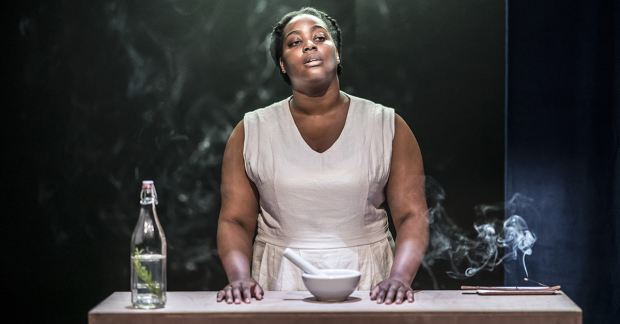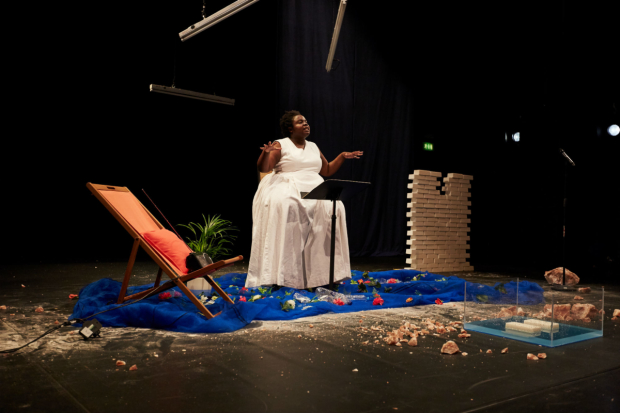Review: Salt. (Royal Court Theatre)

© Johan Persson
Entering the Jerwood Theatre Upstairs, the sweet smell of incense hangs in the air. Performer Rochelle Rose stands still and observes the audience carefully as they enter. She wears a long, flowing white dress, which gives her an ethereal quality. Yet as she steps out from behind a table, we see she is wearing thick, black boots. Katherine Radeva's design hints at the idea that although Salt. is a spiritual diasporic journey, this comes at the cost of the very real, grounded labour which comes with unpacking inherited trauma.
In 2016 Selina Thompson retraced the route of the Transatlantic Slave Triangle. She was trying discover what it means to possess a residual trauma, to descend from enslaved ancestors and importantly, what it means to exist and be educated in white institutions whilst in a black body. What she brought back from this journey was salt – lots and lots of large, pink rock salt. Of course, it's not enough to contain a whole history of black lives, but Rose tells us that this salt is, above all, "for our wounds". Originally performed by writer Thompson, this is the first time Rose has taken on the role of Woman, and it's a part she inhabits so powerfully that we truly believe this is her own embodied experience as a black woman.
One of the most affecting moments of the play involves a sledgehammer, protective goggles, and a large mound of pink salt that Rose places carefully on the ground. She tells the story of her experiences onboard the boat, with a racist boat master who refers to her people as 'niggers', and how she feels alienated by the crew. As Rose dons the goggles, the audiences in the front two rows do the same. She smashes at the salt repeatedly, each fragment growing to represent individuals in a chain reaction of imperialism, racism and capitalism. The salt shards at the top of the chain are impacted the least, then the union, then the supervisors, the workers, and finally, the two black women aboard the ship, whose salt fragments are smashed to smithereens by the end of it all. We are left with a devastating visual declaration of societal hierarchy.
Radeva's design is simple and clean. Three fluorescent strips of light form the shape of a triangle, which is suspended downstage. A wooden table balances a bottle of water, incense and a pestle and mortar. Upstage right there is a high chair surrounded by tall, leafy plants. There is also a microphone set against a hanging velvet curtain. Rose travels between each of these destinations, as she talks about travelling between Europe, Africa and the Caribbean. Despite this being a story of travelling back and unravelling complicated feelings, the set is made of natural materials and feels both clean and welcoming.
Complimenting this stage design is the continuous soundscape composed by Sleepdogs, which ebbs and flows, sometimes at great volume, and, at other times, we are plunged into silence to emphasise Rose's words. The sound design provides us another way in; to understand the constant feeling of being onboard the ship way out in the middle of the ocean. The soundscape also provides a small moment of comedy, such as when snippets of Drake's "Hotline Bling" unexpectedly begin to play, as Rose tells us how, locked in the bottom of the cargo ship, Drake's music runs through her head.
It's a heavy story made endurable by Rose's grounded performance, small breaths of humour, and by the strength of the writing itself; if Rose can – must – go through this journey of racism and imperialism, so can we.
At the end, we are invited to take a piece of smashed salt, wrap it up and take it home with us, as a reminder of why we live and a reminder of where we all come from.

















